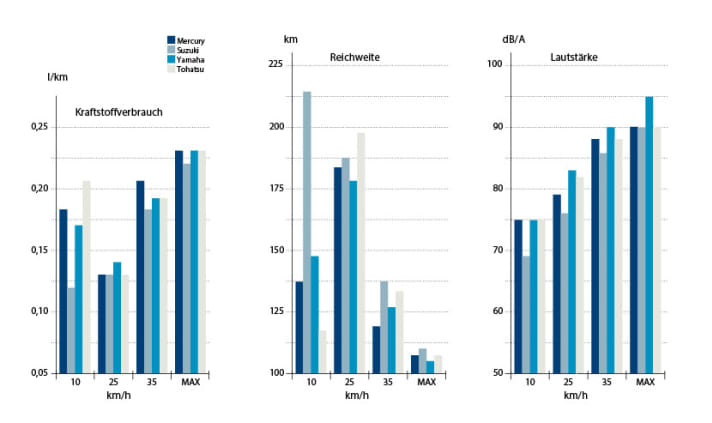
In many industries, including the engine industry, standing still means taking a step backwards. It is therefore not surprising that engine manufacturers are endeavouring to keep all their models up to date. This also applies to the25 hp classwhich we last put to the test in 2007.
In this test, we show what the engineers and technicians have improved since then. Suzuki has even come up with a completely new 25cc engine, which it claims is state-of-the-art in this class.
In general, the 25 hp engines find theirWorking on the transom of larger inflatable or small, open sports boats. For our engine test we had aZoom SP 450 aluminium inflatable boat from Zodiac available. It has an overall length of 4.5 metres and measures 1.8 metres in width. It is approved for up to 40 hp. You can read how it performed in the BOOTE test in combination with the Mercury F25 in the 03/15 issue of BOOTE.






Let's move on to the engines and manufacturers who accepted BOOTE's invitation to test 25 hp outboards. In alphabetical orderMercury F25 MLH, Suzuki DF25 AL, Tohatsu MFS25C L and most recently Yamaha F25 DMHL The results were compared directly with each other in the categories of speed, consumption, acceleration, noise and handling.
However, anyone who is familiar with the engine market will know that not all manufacturers offer outboards in this power class. That's right: According to BPR/Evinrude, it was a timing problem, as they were busy with the market launch of the Evinrude G2, and the importers of the Parsun and Selva brands did not respond to our enquiry.
Let's get to the facts: Mercury, Suzuki and Tohatsu all use an in-line three-cylinder four-stroke engine under the non-insulated plastic bonnets, which are only fitted with a water separator. Yamaha continues to rely on an in-line two-cylinder engine in this power class, which also works on the four-stroke principle.
Whereas Suzuki and Yamaha used to rely on carburettors (2007), they have now switched to carburettors, just like their competitors Mercury and Tohatsu back then.Electric fuel injection systems changed over. In addition to the mixture preparation, all four engines have other things in common when it comes to the full-load speed range. All four models areMaximum speeds between 5000 rpm and 6000 rpm designed.
In terms of weight, there is often a difference between the factory specifications and our measurements. We always measure the outboards in ready-to-run condition, i.e. with propeller and engine oil. The lightest engine in our test weighed 66.3 kg and the heaviest 81.6 kg. Accordingly, the Suzuki deserves the title of lightweight and the Yamaha has to take thePredicate "lead duck" put up with.
As "Lame duck", the F25 DMHL (Yamaha) may be used, however, with an achievedMaximum speed of 40.2 km/h. This speed makes it the fastest in the comparison. But the competition isn't much slower either, with the field of four engines being divided by exactly 1 km/h. We noticed a clearer difference in theNoise measurement is fixed. This is where the only two-cylinder engine in the test makes a negative impression. It is already noticeable acoustically in the medium speed range.
At full load, it is then unmistakably audible with a value of 95 db/A. In comparison, the Mercury, Suzuki and Tohatsu brands are more tolerable with a measured 90 db/A.The new Suzuki is a consistently quiet engine. With 69 db/A at 10 km/h (channel speed) and thus 6 db/A less than the other engines, it is clear that the engine manufacturer's engineers have done their homework.
However, this is also clear in the mid-range. There, the Suzuki remains the quietest engine by a small margin. In the next category, accelerating from idle to 35 km/h, the Suzuki is also just ahead of the Yamaha.
Apparently, the new DF25A L design is unbeatable for the competition in terms of measurements. But what about theEase of use and storage options off? For the former, Mercury offers the twist throttle and shift tiller. There are only two options here, you either like it or you don't. I find the tiller practical for mooring, as you can shift gears, steer and accelerate with one hand.
With the other engines, you have to turn round and change gear with your second hand while you accelerate and steer with the other. A compact pack size is important if the engine is to be transported in the boot, for example. To achieve this, the tiller on the Suzuki can be folded up by 90°. The Tohatsu with 100° and the Yamaha with 120° can do this somewhat better, making the outboards more compact and easier to stow.
Let's come to the conclusion. The Yamaha F25 DMHL accelerates the test boat to 35 km/h in 5.5 seconds, with a top speed of 40.2 km/h. These are not bad results, but the engine is too loud. With a price of €4565, the two-cylinder engine doesn't really score points either, which puts the Yamaha in last place. Mercury and Tohatsu form the rock-solid midfield in our test.
There are no notable outliers in the measured values. When it comes to handling the controls, the Mercury provides more comfort when docking after a short familiarisation phase with the rotary throttle tiller. Both models are also real price breakers. TheTohatsu costs € 4190 and the Mercury goes for € 4165 over the counter. This makes both engines over €500 cheaper than the most expensive engine in the test.

A certain superiority of the new Suzuki DF25A L over its competitors cannot be denied in view of the test results. The Suzuki is quieter, more economical, accelerates better and is very light. The extent to which this justifies the price of 4700 € is up to each skipper, but the DF25A L is certainly convincing in purely technical terms.

